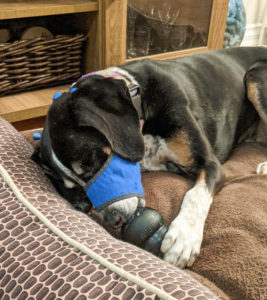The word muzzle can conjure up all kinds of negative words: aggressive, biter, and dangerous among them. The overall impression of a muzzled dog is that they are a "bad dog". However, it's important to note that dogs that are wearing a muzzle could be wearing one for any number of reasons. While the most common reason is to prevent a bite, that also doesn't make the dog wearing it a "bad dog." Dogs do not try to bite without reason and, in the majority of cases, the reason is that they are scared or painful and trying to protect themselves.
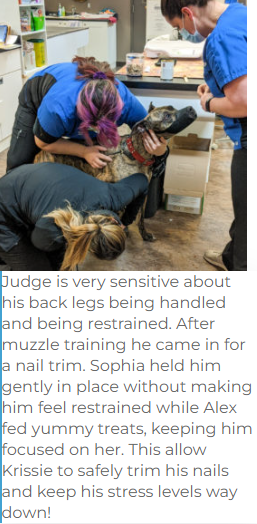 Muzzles aren't meant to punish these dogs, they are an important tool to help us examine them safely, when needed. The veterinary environment can be a particularly tough environment. Despite efforts to reduce stress in our patients, some have had negative experiences in the past or may come in with an injury or illness that may make them defensive. Other times, we may need to deliver injections or other treatments that may be painful. In some cases, the patient may get more stressed with restraint, even gentle restraint, for treatment delivery and so a muzzle may be placed as a back-up while we examine them without a holder. Sometimes, delaying procedures until a pet's fear and stress can be alleviated is a great option, but, when this is not possible, a muzzle can be useful.
Muzzles aren't meant to punish these dogs, they are an important tool to help us examine them safely, when needed. The veterinary environment can be a particularly tough environment. Despite efforts to reduce stress in our patients, some have had negative experiences in the past or may come in with an injury or illness that may make them defensive. Other times, we may need to deliver injections or other treatments that may be painful. In some cases, the patient may get more stressed with restraint, even gentle restraint, for treatment delivery and so a muzzle may be placed as a back-up while we examine them without a holder. Sometimes, delaying procedures until a pet's fear and stress can be alleviated is a great option, but, when this is not possible, a muzzle can be useful.
That being said, our aim to reduce fear, anxiety and stress in our patients becomes even more difficult if the muzzle itself induces a stress response. This can happen when a muzzle is only placed during fear-inducing events. It may work the first few times but animals are smart and will often quickly learn that having a muzzle applied means bad things (or what they perceive to be bad things, even if we know we are trying to help) are about to happen! In some cases animals will become more defensive and potentially aggressive when they see the muzzle and this can further hinder any attempts to deliver treatment.
One excellent solution to this is muzzle training. Muzzle training is something from which every dog can benefit. Even if there are no issues now, you never know when circumstances could change and again, aggression isn't the only reason for a muzzle. Perhaps your dog is hospitalized and has a tendency to chew the IV line, or has a tendency to eat things they shouldn't on a walk (a muzzle can be excellent to ensure they stay safe while training for this). Or perhaps they are a big dog that has a bandage or incision that they try to chew but the e-collar is so big that they end up being destructive or have difficulty navigating small areas.
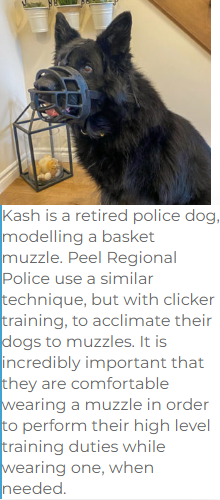
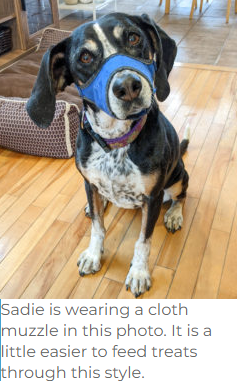 If you have a dog who has required a muzzle in the past, first of all, talk to us about ways that we can help reduce your pet's anxieties in the first place. Next, start muzzle training, it's a huge help! Luckily muzzle training is pretty easy to do! All you need is a yummy treat, a properly fitted muzzle, time, and patience.
If you have a dog who has required a muzzle in the past, first of all, talk to us about ways that we can help reduce your pet's anxieties in the first place. Next, start muzzle training, it's a huge help! Luckily muzzle training is pretty easy to do! All you need is a yummy treat, a properly fitted muzzle, time, and patience.
Muzzle fitting:
There are 2 main types: basket or cloth. Cloth masks can be easier to deliver treats through, but basket muzzles can be worn comfortably for longer periods of time as it allows your dog to pant and is generally a better all purpose muzzle. The two types of muzzles look and feel different so if your dog is trained to one you should still start at the beginning to train to the other.
Training technique
1. Work in short periods, 3-5 minutes chunks of time for this exercise.
2. Find a treat that your dog loves, ideally something that can be broken into small pieces and reserve this treat only for muzzle training. It's even better to also do this exercise before a meal when your pet is hungry so that they are even more food motivated.
3. It's vital that you not advance to the next step until your pet is 100% comfortable with the current phase. You will have much better success taking it slow then by trying to advance too quickly. Signs that your dog is not fully comfortable may include: failure to accept the treat, running away between treats or leaning back to try and create as much distance as possible while taking the treat. You may move through some steps faster than others (for example your dog may be happy to place his nose through the muzzle but gets nervous when it actually gets clipped on). This training should be enjoyable!
4. Start by making sure your dog associates the sight of the muzzle with the treat by feeding them while holding the mask in their view (if your dog is already fearful of the muzzle this may take longer and you may have to start with the muzzle further away).
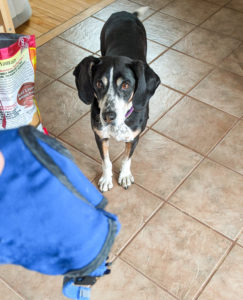
5. Next, start feeding treats through the mask but do not attempt to slide it up over their nose.
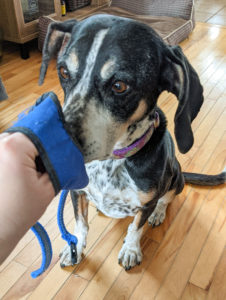
6. Once this can be done without any sign of hesitation you can try holding the treat a little further away from the end of the mask so that your dog has to put their nose through it to reach the treat. Don't advance the muzzle yourself, let your dog make the choice to advance their nose.
7. Then you can actually clip the muzzle behind their ears, feed a treat and take it off again. Let them place their nose through, clip, treat, remove. Do this over and over, very slowly increasing the length of time they keep it on. Initially it will be for 1second, then 2-3, then 10, feeding treats the whole time.
8. Finally, you can start decreasing the frequency of treat delivery while they wear the muzzle.
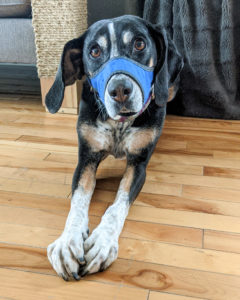
9. The last step is to simply repeat muzzle application intermittently, maybe just for a few minutes each night, always assessing if it's causing any stress. Ultimately the goal is that they should actually enjoy wearing it or, at the very least, are indifferent to it, no different than their collar.
